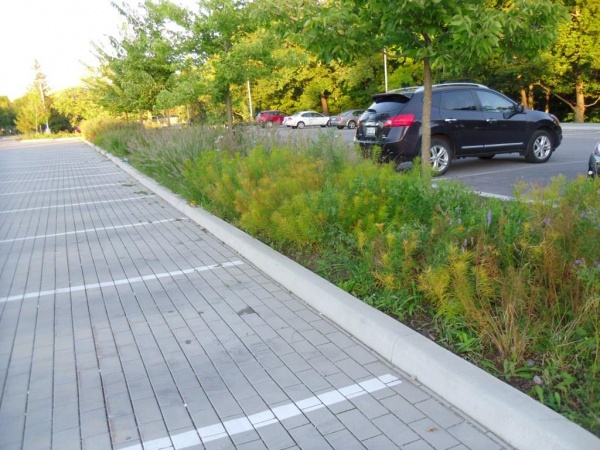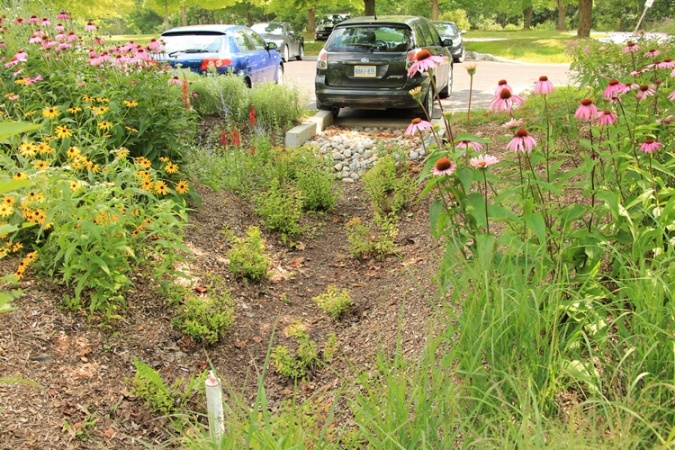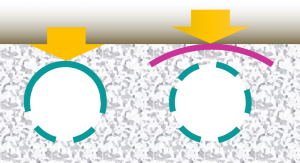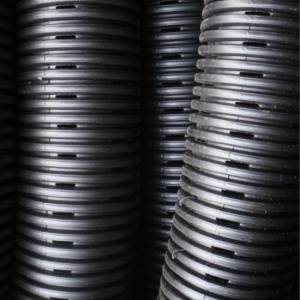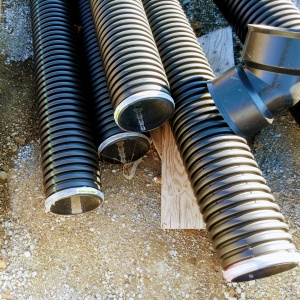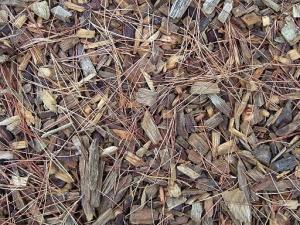Bioretention
This article is about planted installations designed to capture surface runoff through an engineered soil with subterranean infrastructure.
For simpler, residential systems, see Rain gardens.
For linear systems, which convey flow, but are otherwise similar see Bioswales.
Overview[edit]
Bioretention cells are one of the most well recognized form of Low Impact Development. They can encompass all mechanisms of action: infiltration, filtration and evapotranspiration.
Bioretention cells are an ideal technology for:
- Fitting functional vegetation into urban landscapes
- Treating runoff collected from nearby impervious surfaces
The fundamental components of a bioretention cell are:
- Biomedia: An engineered soil mix
- Planting
- Storage layer of coarse aggregate
- Under-drain to redistribute or remove excess water
- Impermeable membrane to prevent infiltration to soils below
<panelSuccess>
</panelSuccess>
Design for maintenance
Will the BMP be a snow storage facility in winter months?
<panelSuccess>
</panelSuccess>
Design[edit]
Pipes
Perforated pipes are a common component of underdrains used in bioretention, permeable pavements, infiltration trenches and exfiltration systems.
Pipes should be manufactured in conformity with the latest standards by the Canadian Standards Association (CSA) or ASTM International.
- Perforated pipes should be continuously perforated, smooth interior HDPE or PVC.
- Wherever possible pipes should be ≥200 mm internal diameter to reduce potential of freezing and to facilitate push camera inspections and cleaning with jet nozzle equipment.
- Smooth interior facilitates inspection and maintenance activities; internal corrugations can cause cameras or hydrojetting apparatus to become snagged.
- A perforated pipe with many rectangular slots has better drainage characteristics than a pipe with similar open area provided by fewer circular holes [1].
- Non-perforated pipes should be used for conveyance of stormwater to and from the facility, including overflow. It is good practice to extend the solid pipe approximately 300 mm within the reservoir or practice to reduce the potential for native soil migration into the pipe.
See also: Flow through perforated pipe
Mulch
- Mulch is considered to be an normal finishing touch to many types of formal landscaping. Maintaining mulch application can help increase aesthetic value of LID BMPs.
- As in other landscaping applications, the mulch helps to preserve soil moisture for plant survival, and suppresses weed growth.
- Mulch can also help to maintain the organic matter content of underlying filter media, which provides cation exchange capacity for pollutant removal.
- Regular fresh applications of wood mulch can also promote denitrification, reducing nitrates in impacted surface waters.
- Mulch should be applied on the surface of the BMP in a layer of 75 -100 mm.
- Double-shredded hardwood or softwood mulch is recommended for LID facilities. Its fibrous texture knits together somewhat; providing limited erosion control.
- In areas with particularly high flow (e.g. around inlets and forebays) coarse decorative aggregate or stone is recommended to better dissipate energy and protect it from erosion.
- This advice also holds for stormwater planters, which often experience concentrated flow from a roof downspout or drain.
- All organic mulches have the potential to float and migrate in surface flow, particularly after a previously dry period. [2]
Vegetation
For a detailed list of recommend plant species, see Plants for bioretention Bioretention plant plan
<panelSuccess>
</panelSuccess>
Performance[edit]
Performance Content
<panelSuccess>
</panelSuccess>
Incentives and Credits[edit]
In Ontario
City of Mississauga
The City of Mississauga has a stormwater management credit program which includes RWH as one of their recommended site strategies[1].
LEED BD + C v. 4
SITES v.2
See Also[edit]
External Links[edit]
[edit]
| SEND US YOUR QUESTIONS & FEEDBACK ABOUT THIS PAGE |
- ↑ Hazenberg, G., and U. S. Panu (1991), Theoretical analysis of flow rate into perforated drain tubes, Water Resour. Res., 27(7), 1411–1418, doi:10.1029/91WR00779.
- ↑ Simcock, R and Dando, J. 2013. Mulch specification for stormwater bioretention devices. Prepared by Landcare Research New Zealand Ltd for Auckland Council. Auckland Council technical report, TR2013/056
